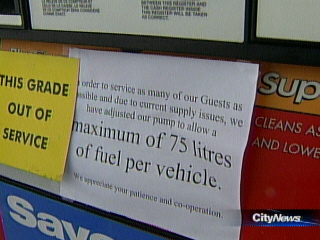Gas Rationing Begins At Some Stations But How Far Will It Go?
Monday February 26, 2007
If the gas situation in the GTA were the flu, you might be concerned that the disease is spreading.
A fire at Imperial Oil’s Nanticoke plant on February 15th has already begun to have a disturbing ripple effect on stations across Ontario.
You know by now that more than 100 Esso outlets province-wide have run out of gas and that the problem has started to afflict some Petro-Canada facilities, as well.
But now a new wrinkle has been added to this tussle of the tanks – gas rationing.
A few Petro-Can stations that are running low on reserves are at least temporarily restricting drivers to just 75 litres of fuel per fill-up.
Pumps have been set to shut off once the magic number is reached and you won’t be able to squeeze any more out of the nozzle.
In some instances, stations have completely run out of super, leaving high-end vehicle owners with no choice but to put in what regular they can get.
Bigger vehicles – like SUVs and minivans – are feeling the initial pinch, but the policy doesn’t apply to every station and isn’t part of a chain-wide movement – yet.
“We wanted to restrict to 75 litres – which is still a significant amount for vehicles – to allow us to spread the available product to as many people as possible,” asserts the company’s Jon Hamilton.
Prices continue to hover around the 96-cent-a-litre mark in Toronto, as the squeeze of the nozzle matches the squeeze on the markets.
Imperial’s fire, the high demand due to the cold weather, rising oil prices on world markets and the CN Rail strike have all combined to make the situation worse.
But the latter problem should be over this week. CN and its striking rail conductors have reached an agreement to return employees to their trains, avoiding back-to-work legislation.
Imperial Oil has been unable to hire trucks to ship the gas here from out of the province, because the big rigs were being tied up by the walkout.
But while the settlement should help, it’s too soon to know exactly when things will get back to normal.
Petro-Canada admits as many as 20-25 of its locations are now without gas, although it’s monitoring all of them to reduce the inconvenience to drivers.
That’s not helping those with an empty tank.
“I thought it was just Esso,” notes one surprised motorist. “I was just down at Evans and Kipling and they’re (Petro-Canada) completely sold out.”
And while consumers insist they’re being gouged, the company blames the incessant demand for the rising prices they’re being forced to pay.
“Well, local market conditions are one factor that go into the price of gasoline but there are a number of others, including the wholesale price of gasoline and the price of crude as people are very familiar with,” contends Petro-Canada’s Michael Southern.
“And we’ve seen those prices as well increasing over the last couple of weeks, and that is having an effect on retail prices at the pump.”
Experts suggest that even if the supplies return, prices could stay high for at least the next month.
Tim Fray can’t wait until then. He drives over 40,000 kilometres a year and the costs are crushing him. “I got out this morning and saw 97 cents. And I go ‘Wow!’ It’s been pretty high!”
There was one other consequence from the fuel fracas.

Canadian Tire had just started a promotion where a selected station would be chosen to dispense gas for 20 cents off the normal price.
It was supposed to last the entire month of February.
But their outlets are supplied by Imperial Oil and many of them have run out of the precious liquid.
So not only can’t they sell gas cheaply, many can’t sell it at all, and the stunt has been put off until the situation is resolved.
Canadian Tire officials call it “a challenge” to meet the fuel demand of consumers. They confirm some of their stations are empty, but say that number varies by the hour.
Sunoco spokespeople are also referring to this as “a challenge,” but maintain none of their outlets have run out of gas.
The government promises that it’s keeping an eye on the prices to ensure there’s no gouging.
“We’re watching very carefully what’s going on as we move to address the temporary supply questions that we’ve run into in Ontario the last week or so,” assures Energy Minister Dwight Duncan.
As for the company that started this fuel cascade, Imperial Oil is forced to concede that its Nanticoke refinery won’t be back at full strength until sometime in April.
In the meantime, it’s looking to get gas for its stations from other suppliers.
The only problem with that? Everyone else is trying to do the same thing.
http://www.citynews.ca/news/news_8211.aspx


